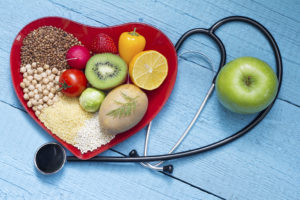It’s estimated that 2 of 3 people with diabetes have high blood pressure. When blood pressure is elevated, your heart works harder to pump blood throughout your body. High blood pressure increases your risk of a heart attack, stroke, kidney disease, and eye problems.
You have already heard about how added salt can increase blood pressure, but did you know that certain foods can help to lower blood pressure? Foods that are high in potassium, magnesium, and calcium can help to regulate blood pressure. Taking these minerals as supplements doesn’t have the same effect as eating foods that contain these. Try eating some of the following foods to boost your intake of nutrients that can lower blood pressure naturally.
- Unsalted Nuts
Nuts are a good source of plant protein and contain the amino acid L-arginine which makes nitric oxide and helps blood vessels relax. While all nuts are a healthy choice, both almonds and pistachios contain the trifecta of potassium, magnesium, and calcium. Nuts are low in carbohydrates and eating nuts has been linked to improved glucose levels.
- Beets
Beets contain nitrates, which are converted to nitric oxide which helps to control blood pressure. Beetroot juice contains higher amounts of nitrates than cooked beetroot. Beetroots contain potassium. For added calcium and magnesium, eat the beet greens as well.
- Yogurt
Yogurt has a bad rap for containing a lot of sugar. It’s true that yogurt may contain both natural sugar (from milk and fruit) and added sugar. There are many yogurts now that are lower in sugar. Yogurt contains calcium and potassium to help blood pressure. It also contains probiotics which can help your gut absorb and use these nutrients better.
- Berries
Berries are high in a phytonutrient called flavonoids. These plant compounds function as an antioxidant, support brain function, and can help to lower blood pressure. All types of berries are a healthy choice and contain fiber which helps to slow the rise in blood glucose. If berries aren’t in season, try frozen berries without added sugar.
- Beans
Beans such as white, navy, pinto, black, and kidney beans and rich in potassium and magnesium and some contain calcium. Canned beans make a quick addition to a meal. Purchase beans without added salt or drain and rise before eating. Beans contain carbohydrates but they are also high in fiber and contain protein to help slow the rise in glucose.
- Leafy Greens
Spinach, kale, swiss chard, arugula, beet greens, cabbage, and collard greens contain potassium, magnesium, and calcium. Each type of green contains varying amounts of these minerals, so eat a variety of greens. Greens also contain nitrates to naturally lower blood pressure. Greens are very low in carbohydrates and high in fiber to help with glycemic control.
- Seeds
Seeds are a good source of magnesium and potassium to help lower blood pressure. Flaxseed, chia seeds, hemp seeds, and pumpkin seeds are all good choices to add to a meal or snack. Look for seeds that are unsalted. Seeds are low in carbohydrates and contain protein and fiber.
If you have high blood pressure, it’s still a good idea to avoid the salt shaker and flavor foods with herbs and spices. Limiting alcohol intake will also help to control high blood pressure. If you are looking for more information on diet and blood pressure, check out the DASH Eating Plan.
by Christine McKinney, RD LDN CDE

